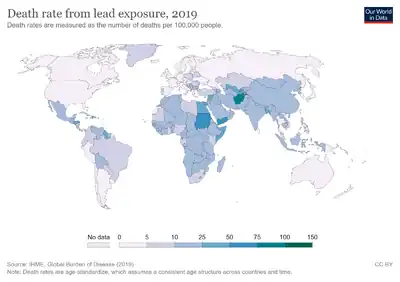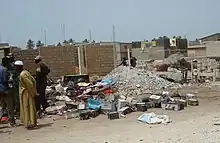Lead poisoning epidemics


Lead poisoning epidemics refer to instances of mass lead poisoning, and usually occur unintentionally in low income countries. Lead recycling is a common cause of a poisoning epidemic, and it is commonplace and sometimes the only means of providing sustenance in poorer countries. The lack of immediate and obvious health effects often result in people taking excessive risks and few precautions when handling lead. These events can also cause disproportionate childhood fatalities, when levels of toxins become fatal in lower concentrations in children compared with adults.
Notable poisoning events
This list does not include episodes of fewer that 100 people affected, nor does it include individual lead paint poisoning cases, nor those caused by eating contaminated food or water. The cases below are discrete events of mass lead poisonings.
| Name of Event | Year | Region | Country | City | # Tested high* | # deaths | Source of Lead Exposure | References | Comments |
|---|---|---|---|---|---|---|---|---|---|
| Dong Mai | 2015 | SE Asia | Vietnam | Dong Mai | 102 | 0 | Auto Battery Recycling | ref[1] | ongoing |
| El Paso/Juarez | 1974 | N.Amer | USA/Mexico | El Paso, Texas | 391 | 0 | Lead Smelter | ref[2] | plant closed |
| Fiengxiang | 2009 | Asia | China | Shanxi | 615 | 0 | Lead Smelter | ref[3] | comment |
| Hunan | 2008 | Asia | China | Hunan | 1354 | 0 | Manganese Factory | ref[4] | comment |
| Jiyuan | ? | Asia | China | Jiyuan | 1000 | 0 | Lead Smelter | ref[5] | 99.7% of children poisoned |
| Doe Run | 2004 | S.Amer | Peru | La Oroya | 100's | 0 | Lead Smelter | ref[6] | plant closed |
| Michoacan | 2009? | C.Amer | Mexico | Michoacan | 311 | 0 | Lead glazed Pottery | ref[7] | ongoing |
| Santo Amaro | 1985 | S.Amer | Brazil | Bahia | 555 | 0 | Lead Smelter | ref[8] | comment |
| Thiaroye Sur Mer | 2008 | Africa | Senegal | Dakar | 150+ | 18 | Auto Battery Recycling | ref[9] | closed |
| Torreon | 2000 | C.Amer | Mexico | Torreon | 11181 | 0 | Lead Smelter | ref[10] | comment |
| Zamfara | 2010 | Africa | Nigeria | Zamfara | 1000+ | 163-400 | Lead mining / ASGM | ref[11] | ongoing |
| Kabwe | 2013 | Africa | Zambia | Kabwe | 1000+ | 0 | Lead mining and smelter | ref[12][13] | comment |
- number tested high is defined as a blood lead level greater than or equal to 10 micrograms per deciliter whole blood (ug/dl)
See also
- List of man-made mass chronic poisoning incidents
- Lead contamination in Washington, D.C. drinking water
- Flint water crisis
- 2009 Chinese lead poisoning scandal
- Exide lead contamination from battery recycling in the U.S.
- Lead contamination in Oakland
References
- ↑ Daniell, William E.; Tung, Lo Van; Wallace, Ryan M.; Havens, Deborah J.; Karr, Catherine J.; Diep, Nguyen Bich; Croteau, Gerry A.; Beaudet, Nancy J.; Bao, Nguyen Duy (2015-10-26). "Childhood Lead Exposure from Battery Recycling in Vietnam". BioMed Research International. 2015: 193715. doi:10.1155/2015/193715. PMC 4637436. PMID 26587532.
- ↑ Ordóñez, Blanca Raquel; Romero, Lidia Ruiz; Mora, Refugio (2003). "Investigación epidemiológica sobre niveles de plomo en la población infantil y en el medio ambiente domiciliario de Ciudad Juárez, Chihuahua, en relación con una fundición de El Paso, Texas". Salud Pública de México. 45: 281–295. doi:10.1590/S0036-36342003000800015. ISSN 0036-3634.
- ↑ Watts, Jonathan; Cui, Zheng (2009-08-17). "Chinese villagers storm factory blamed for lead poisoning of 600 children". The Guardian. ISSN 0261-3077. Archived from the original on 2016-03-01. Retrieved 2016-02-19.
- ↑ Watts, Jonathan; correspondent, Asia environment (2009-08-20). "1,300 Chinese children near smelter suffer lead poisoning". The Guardian. ISSN 0261-3077. Archived from the original on 2016-03-01. Retrieved 2016-02-19.
- ↑ "China to move residents from lead smelter base-report". Reuters. 2009-10-19. Archived from the original on 2016-02-24. Retrieved 2016-02-19.
- ↑ Fraser, Barbara (2009-07-01). "La Oroya's Legacy of Lead". Environmental Science & Technology. 43 (15): 5555–5557. doi:10.1021/es901734g.
- ↑ Fernandez, G. O.; Martinez, R. R.; Fortoul, T. I.; Palazuelos, E. (1997-02-01). "High blood lead levels in ceramic folk art workers in Michoacan, Mexico". Archives of Environmental Health. 52 (1): 51–55. doi:10.1080/00039899709603800. ISSN 0003-9896. PMID 9039858.
- ↑ Lalor, G. C.; Vutchkov, M. K.; Bryan, S. T.; Christie, C. D. C.; Donaldson, D.; Young, J.; Chambers, S. (2006-12-01). "Acute lead poisoning associated with backyard lead smelting in Jamaica". The West Indian Medical Journal. 55 (6): 394–398. doi:10.1590/s0043-31442006000600005. ISSN 0043-3144. PMID 17691233.
- ↑ Jones, Donald E.; Diop, Assane; Block, Meredith; Smith-Jones, Alexander; Smith-Jones, Andrea (2011). "Assessment and Remediation of Lead Contamination in Senegal". Journal of Health and Pollution. 1 (2): 37–47. doi:10.5696/2156-9614.1.2.37.
- ↑ US Centers for Disease Control (203). "Blood Lead Levels and Risk Factors for Lead Poisoning Among Children in Torreón, Coahuila, Mexico" (PDF). United States Centers for Disease Control and Prevention National Center for Environmental Health, Lead Poisoning Prevention Branch/Health Studies Branch.
{{cite journal}}: CS1 maint: url-status (link) - ↑ "WHO | Nigeria: mass lead poisoning from mining activities, Zamfara State". www.who.int. Archived from the original on July 8, 2010. Retrieved 2016-02-19.
- ↑ Yabe, John; Nakayama, Shouta M. M.; Ikenaka, Yoshinori; Yohannes, Yared B.; Bortey-Sam, Nesta; Oroszlany, Balazs; Muzandu, Kaampwe; Choongo, Kennedy; Kabalo, Abel Nketani (2015-01-01). "Lead poisoning in children from townships in the vicinity of a lead–zinc mine in Kabwe, Zambia". Chemosphere. 119: 941–947. doi:10.1016/j.chemosphere.2014.09.028. hdl:2115/58817. PMID 25303652.
- ↑ "Notes from the Field: Severe Environmental Contamination and Elevated Blood Lead Levels Among Children — Zambia, 2014". www.cdc.gov. Archived from the original on 2016-03-02. Retrieved 2016-02-19.